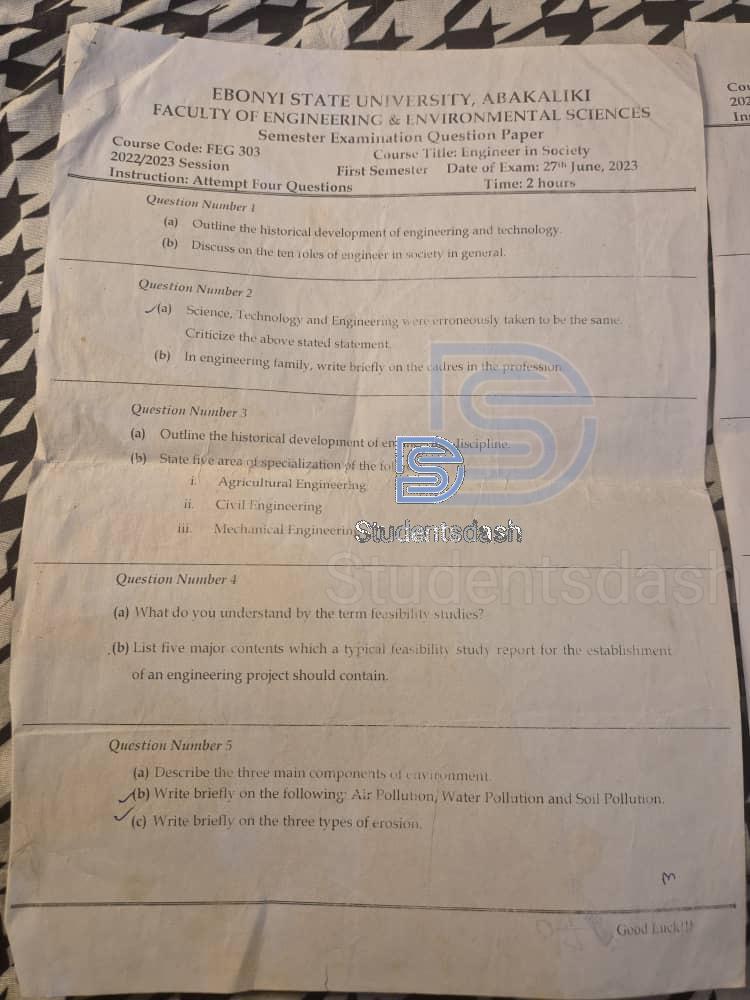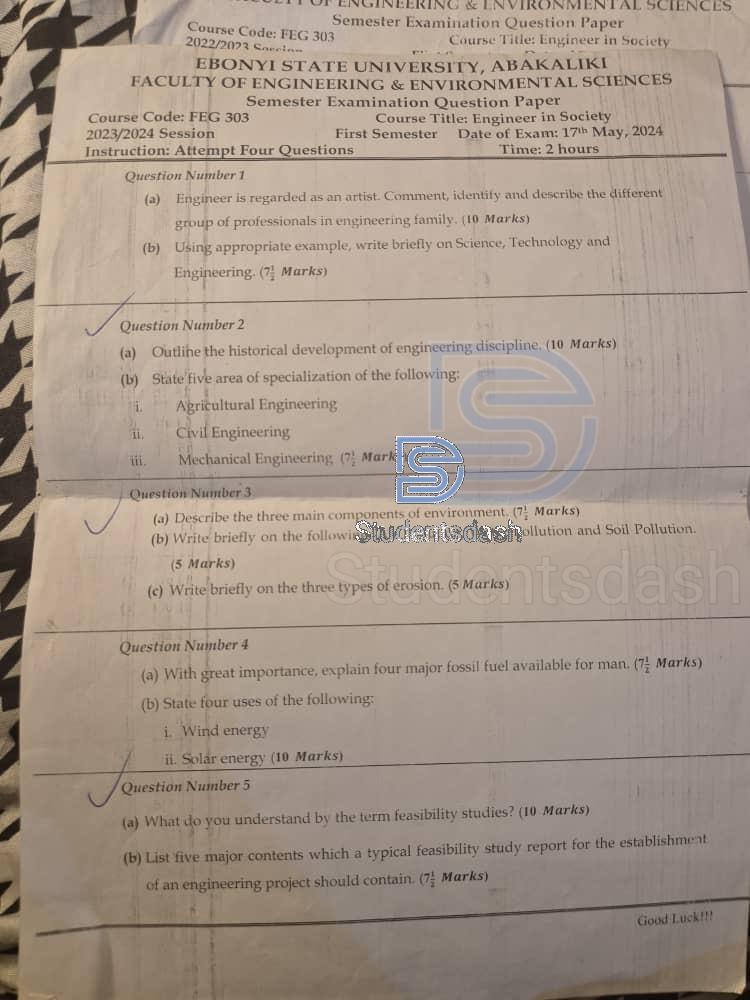GET 101 / FEG 303 Past Questions and Answers


2023 Paper Solutions
Question Number 1
(a) Outline the historical development of engineering and technology.
Engineering and technology started from the early days when humans used stones and sticks to make tools for hunting and farming. This was called the Stone Age. Later, during the Bronze Age, people started using metals like bronze to make better tools and weapons. Then came the Iron Age, where iron was used to build stronger tools, which improved farming and construction.
As time went on, the Industrial Revolution in the 18th and 19th centuries changed everything. Machines were built, and industries like textile, mining, and transport grew fast. Steam engines, electricity, and railways were all major engineering achievements.
In the 20th century, engineering became more advanced with the invention of cars, airplanes, computers, and mobile phones. Now, we are in the digital age, where engineers are using artificial intelligence, robotics, and modern software to solve problems and improve life.
So, engineering has moved from using simple tools to building complex machines and systems that shape our modern world.
(b) Discuss on the ten roles of engineer in society in general.
- Problem Solvers – Engineers find solutions to technical and social problems.
- Designers – They design buildings, roads, machines, and other structures.
- Innovators – Engineers develop new ideas and technologies to improve life.
- Planners – They plan how projects like bridges or factories will be built.
- Builders – Engineers supervise the construction of projects.
- Maintainers – They help maintain machines, roads, and infrastructure.
- Economy Boosters – Engineering projects create jobs and support economic growth.
- Safety Officers – They ensure that structures are safe for use by people.
- Environmental Protectors – Engineers work on clean energy and waste management.
- Educators and Researchers – Some engineers teach or research new technologies.
Question Number 2
(a) Science, Technology and Engineering are erroneously taken to be the same. Criticize the above stated statement.
Science, technology, and engineering are related, but they are not the same.
Science is about discovering knowledge and understanding how nature works. Scientists ask questions and carry out experiments to find out the truth. For example, studying how gravity works or how plants grow is science.
Technology is the practical use of scientific knowledge. It involves creating tools or machines to solve problems. For example, using scientific knowledge to build a mobile phone or computer is technology.
Engineering is the process of designing, building, and maintaining structures, machines, and systems using both science and technology. Engineers take scientific knowledge and turn it into useful products or systems.
So, even though they are connected, science discovers, technology applies, and engineering builds. People confuse them because they often work together, but they are different in purpose and process.
(b) In engineering family, write briefly on the cadres in the profession.
In the engineering profession, there are different levels or cadres. These include:
1. Technician – They handle basic technical tasks like maintenance and support under the supervision of engineers.
2. Technologist – They have more advanced training than technicians and assist engineers in designs, tests, and projects.
3. Graduate Engineer – This is someone who just completed a degree in engineering and is gaining experience.
4. Corporate Engineer – These are experienced engineers who are fully registered with professional bodies like COREN in Nigeria.
5. Senior Engineer – They supervise junior engineers and lead projects.
6. Chief Engineer/Director – They are in top positions, making decisions and overseeing large engineering operations.
Each cadre plays an important role in making engineering projects successful.
Question Number 3
(a) Outline the historical development of engineering discipline.
The engineering discipline developed over a long time. It began in ancient times when early humans used stones, wood, and bones to create tools for survival. As people started building houses and roads, they used simple engineering ideas without knowing it.
In ancient Egypt and Mesopotamia, engineers built big structures like pyramids and irrigation systems. Later, the Romans improved engineering by building roads, bridges, and aqueducts.
During the Middle Ages, engineering was mostly used for building castles and war machines. In the Renaissance period, engineering became more scientific, with people like Leonardo da Vinci designing machines.
The Industrial Revolution in the 18th and 19th centuries changed everything. New machines, factories, and steam engines were built. This led to the creation of different branches like mechanical and civil engineering.
In the 20th century, new fields like electrical, computer, and chemical engineering developed. Today, engineering keeps growing with modern fields like software engineering, robotics, and bioengineering.
(b) State five area of specialization of the following:
i. Agricultural Engineering
- Farm machinery and mechanization
- Soil and water engineering
- Irrigation and drainage systems
- Food processing and storage
- Agricultural structures
ii. Civil Engineering
- Structural engineering
- Transportation engineering
- Geotechnical engineering
- Water resources engineering
- Environmental engineering
iii. Mechanical Engineering
- Thermodynamics
- Fluid mechanics
- Heating, ventilation and air conditioning (HVAC)
- Machine design
- Manufacturing and production engineering
Question Number 4
(a) What do you understand by the term feasibility studies?
Feasibility studies are investigations or checks carried out before starting an engineering project to know if the project is possible, realistic, and worth doing. It helps to find out if the project can be completed successfully based on cost, time, location, resources, and other important factors.
The main purpose is to reduce risk and make better decisions before spending a lot of money or time on the project. If a project is not feasible, it may be canceled or changed.
(b) List five major contents which a typical feasibility study report for the establishment of an engineering project should contain.
- Technical Feasibility – Checks if the project can be done with the available technology, tools, and skills.
- Economic/Financial Feasibility – Looks at the cost of the project and if it will be profitable or affordable.
- Legal Feasibility – Ensures the project follows government laws, building codes, and safety rules.
- Environmental Feasibility – Studies the effect of the project on the environment (e.g., pollution or land use).
- Operational Feasibility – Checks if the project
Question Number 5
(a) Describe the three main components of environment.
The three main components of the environment are:
1. Biotic (Living) Components – These include all living things like humans, animals, plants, and microorganisms.
2. Abiotic (Non-living) Components – These are non-living things like air, water, soil, sunlight, and temperature.
3. Cultural or Human-made Components – These are things made by humans like buildings, roads, vehicles, and industries.
All these components work together to support life and shape the world we live in.
(b) Write briefly on the following:
Air Pollution:
This happens when harmful gases, smoke, or dust are released into the air, making it unsafe to breathe. It is caused by things like car fumes, factory smoke, and burning of waste.
Water Pollution:
It is the contamination of water bodies like rivers, lakes, and oceans. It is caused by dumping of waste, oil spills, or chemicals into the water, which makes it harmful for drinking, farming, or aquatic life.
Soil Pollution:
This occurs when harmful substances like chemicals, plastics, or waste are dumped on the land. It reduces soil fertility and can affect plants, animals, and humans.
(c) Write briefly on the three types of erosion.
1. Sheet Erosion:
This is when a thin layer of topsoil is removed evenly from the land surface by rainwater.
2. Rill Erosion:
This happens when small channels or rills are formed on the soil surface by running water.
3. Gully Erosion:
This is the most serious type. It occurs when water cuts deep and wide channels (gullies) into the soil, damaging land and roads.
